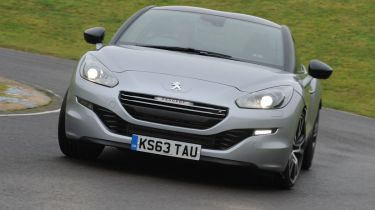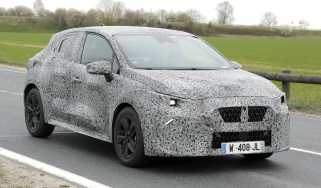Peugeot RCZ R (2014-2015) review
The Peugeot RCZ R is fast, light and packed with track-inspired technology

With its sharp steering and chassis set-up, the Peugeot RCZ already handles very well for a front-wheel-drive performance car. But the new RCZ R, developed by racing engineers at Peugeot Sport, takes things a step further. Faster, lighter and more precise, it’s packed with track-inspired technology.
Engines, performance and drive
As nice as the RCZ R is to look at, the driving experience has to be good enough to justify the £5,360 premium over the standard THP 200. Thankfully, a glance at the spec is enough to confirm it’s no half-hearted special edition.
Under the bonnet, the brand’s proven 1.6-litre turbo petrol engine has received comprehensive attention from Peugeot Sport. The block has been reinforced, while new forged pistons and coated conrods further beef things up. Elsewhere, the twin-scroll turbocharger has been upgraded and tuned to work with the steel exhaust manifold. From the moment you set off, the Peugeot feels intoxicatingly quick. The sharp throttle response and punchy delivery offer serious pace.
The power really starts to build from 2,000rpm, remains eager through the mid-range and has a final flurry from 5,500rpm to the 6,500rpm red line. As you accelerate out of tight corners, the R’s Torsen limited-slip diff helps you stay on your chosen line with surprisingly little steering interference. It’s only on cambered surfaces that you get any squirming, and even then the traction control is smooth.
Used - available now

2022 Kia
Stonic
26,003 milesManualPetrol1.0L
Cash £13,400
2022 Volvo
XC40
73,209 milesAutomaticPetrol1.5L
Cash £17,800
2020 BMW
2 Series Gran Coupe
64,132 milesManualPetrol1.5L
Cash £14,900
2022 BMW
X1
25,617 milesAutomaticPetrol2.0L
Cash £22,800The combination of strong front-end grip and fast steering lets the R dart into corners. On the road, there’s so much grip that you’re unlikely to reach the limits of the chassis. It’s only on a track with the stability system off that you’re likely to experience the more extreme edge of its handling. Here, taut body control and 44 per cent stiffer rear suspension mean the Peugeot’s rear can snap suddenly sideways when the tyres are cold.
However, there’s always enough feedback and adjustability to make it fun. You can certainly feel the race-inspired chassis work: the track, toe-in and camber are optimised for the wider 19-inch alloys. Plus, stiffer springs and reworked dampers are matched to a roll centre closer to the centre of the car to improve agility. The focused set-up makes for a firm ride, but damping is excellent. Plus, an acoustic windscreen reduces road noise compared to the Nissan, and the bassy exhaust rasp doesn’t get boomy on the motorway. Strong brakes from the 206 World Rally car and a snappy gearshift complete an extremely accomplished driving experience.
MPG, CO2 and Running Costs
With a small-capacity turbo engine and relatively low weight, the RCZ R proves that fast coupes can be efficient. It emits just 145g/km of CO2, meaning a 21 per cent company car tax rating. So a higher-band earner will pay £2,671 a year – £2,383 less than for the 370Z. During our time with the RCZ R we averaged just shy of 30mpg, so fuel bills shouldn’t break the bank, either.
Peugeot’s servicing is expensive, but stronger residuals mean you’ll suffer less depreciation. Our experts predict the RCZ will retain 43 per cent of its list price in three years. That’s £18,237 of depreciation, or £3,183 less than a 370Z. The Peugeot is also over £200 a year cheaper to insure.
Interior, design and technology
Bold concept-car styling means the RCZ has always stood out from the crowd. Last year’s facelift freshened the looks with a smaller full-width grille, but the rest of the car’s stunning lines were left unchanged. That means you get the long wheelbase, sweeping profile, double-bubble canopy and arching roof rails that make the RCZ such a head-turner.
The purposeful-looking R sits 10mm lower than the standard car, plus it gets wider forged 19-inch wheels, matt-black roof arches, titanium-tinted xenon headlights and a fixed spoiler. While it’s not as aggressive-looking as the Nissan 370Z Nismo, it’s much classier. Open one of the long doors and you’re greeted by a Peugeot Sport logo on the sill, while smart red stitching across the dash and doors gives the cabin an upmarket feel. Like the standard RCZ, the dials, analogue clock and circular vents are all chrome-ringed, and material quality is a step ahead of the 370Z’s.
Standard equipment includes sat-nav, auto wipers, rear parking sensors and Bluetooth. It’s just a shame the small stereo buttons and over-complicated navigation are fiddly to use.
Practicality, comfort and boot space
Thanks to its wide 309-litre boot and folding rear bench seat, the RCZ is more practical than you might think. The rear seats could carry adults on very short journeys, but in reality they’re more suited to occasional use by children.
With a good range of wheel and seat movement, you can easily get into a comfortable driving position, so day-to-day usability is excellent.
However, the interior is hobbled by poor storage: the door bins are narrow and the fusebox takes up half the glovebox’s space. There’sno spare wheel, either –you have to rely on sealant.
Reliability and Safety
Hopefully, Peugeot Sport’s motorsport pedigree and focus on high-quality engineering will have a positive effect on reliability, as Peugeot ranked a lowly 31st in our Driver Power 2013 satisfaction survey. Like all RCZs, the R is made by Magna Steyr in Austria, while safety kit includes four airbags and rear-seat ISOFIX.







